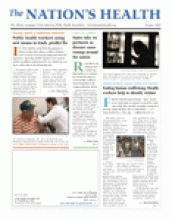On Aug. 4, I visited the Kewa Pueblo, just north of Albuquerque, N.M., at the invitation of former APHA President Michael Bird, a member of the pueblo. Formerly known as the Santo Domingo Pueblo, Kewa is a Keresan dialect-speaking pueblo that was celebrating a saint’s day with ceremonies, including a nearly unceasing set of dances in the hot, dusty sun. Kewa Pueblo is a very traditional pueblo in which religious ceremonies may not be photographed or recorded.
At 9 a.m., we gathered on the plaza in quiet expectation. Soon, a single drum heralded the approach of a group of men, who gathered in an area at the other end of the square and began singing. A seemingly endless line of dancers — men, women and children — followed a lead dancer who carried the flag of their clan. In perfect formation, they moved in unison, women with headdresses and black wool dresses, men in breechcloths, all of them following the flag bearer. A thousand dancers gradually filled the square.
Subtle changes in the drumming and songs would signal the dancers, who would change their rhythms and steps in unison and the direction of their dance. After a dance that seemed to last for about an hour, the first group left and a second group of a thousand dancers came, with subtly different details in their dress. In the heat and dust, their concentration, stamina and grace was testimony to a tremendous amount of conditioning and practice. The two groups alternated dancing for the entire day.
During the break between dances, we were invited into people’s homes to eat. The pueblo’s main square is lined with rows of adobe homes, and we entered their cool spaces to find large tables laid out with bowls of fruit and macaroni salad and set for perhaps a dozen guests. Michael would greet his family members and friends, and once we sat down, women would come out with steaming bowls of “pozole,” red and green chili and beans. We ate at several people’s homes before going back to town, exhausted.

When we, as public health workers, discuss the American Indian community in our terms, we see persistent deficits, poverty, school abandonment and alcohol. But when I witnessed this community coming together and executing the exquisiteness of this community dance, written by centuries of tradition, the sheer magnitude of this spectacle moved me almost to tears. I cannot sufficiently relay the sense of awe that I felt watching the dancers reinforce the values of culture and community.
If they could come together and do this, Michael asked me, what might they do if they focused that energy and activity on the health of their community?
Michael wrote me later about the day, noting that “as you can see, we have significant challenges and health disparities, but we are not only disparities. We are a community of people who have survived for thousands of years and have faced significant challenges, but we still are here. There are lessons for all of us.”
- Copyright The Nation’s Health, American Public Health Association









